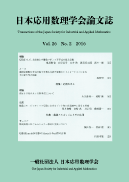
- Issue 4 Pages 197-
- Issue 3 Pages 105-
- Issue 2 Pages 44-
- Issue 1 Pages 1-
- |<
- <
- 1
- >
- >|
-
Kazufumi Ozawa2021 Volume 31 Issue 2 Pages 44-62
Published: 2021
Released on J-STAGE: June 25, 2021
JOURNAL FREE ACCESSAbstract. A numerical method for solving the real root of nonlinear real-valued scalar equation by multiple-precision arithmetic is developed. The method is an extension of inverse interpolation methods. The method proceeds to the next step with only half the cost of the Newton method, since the method is derivative free and requires only one function evaluation per step. The rate of convergence of the method is shown to be quadratic or super-quadratic, depending on the equation. As a result the method attains the efficiency index 2 or more, which is the largest among the existing ones. Numerical experiments using a multiple-precision library show the efficiency of the method.
View full abstractDownload PDF (2480K) -
Naoya Takakura, Ken'ichiro Tanaka2021 Volume 31 Issue 2 Pages 63-75
Published: 2021
Released on J-STAGE: June 25, 2021
JOURNAL FREE ACCESSAbstract. For analytic functions characterized by weight functions expressing the decay properties of the functions, an interpolation type approximation formula has been devised by Sugihara, and it is known that optimal accuracy can be achieved with appropriate sampling points. In particular, when the weight decay exponentially, the best way to take sampling points is also known, and another formula has been devised by Ushima. In this paper, we extend Ushima's formula to the case when the weight function is general and perform error analysis. Numerical experiments showed that the extended Ushiima's formula was more accurate than Sugihara's formula in some cases.
View full abstractDownload PDF (2426K)
-
Mitsugu Mera, Yusuke Nakamura, Toshihiro Yoshida, Keigo Shimizu, Sho K ...2021 Volume 31 Issue 2 Pages 76-104
Published: 2021
Released on J-STAGE: June 25, 2021
JOURNAL FREE ACCESSAbstract. We describe our own method (which we call "Graph Structured Analysis" including a series of processes) to aim at promoting knowledge discovery towards clarifying the mechanisms of complex phenomena from various time series data. This method is based on Bayesian networks and supports structurally analyzing and visualizing the relationships among multiple variables with time series data. We show some examples of applying this method to actual time series data acquired in our development area of automobiles. In each example, we discuss its utility while giving interpretations along engineering viewpoints.
View full abstractDownload PDF (5150K)
- |<
- <
- 1
- >
- >|